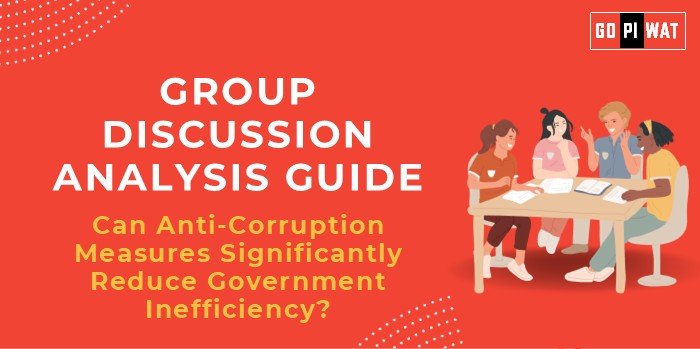📋 Group Discussion Analysis Guide: Can Anti-Corruption Measures Significantly Reduce Government Inefficiency?
🌐 Introduction
Corruption erodes public trust, siphons resources, and undermines governance worldwide. It directly impacts government efficiency, creating systemic barriers to development and equitable service delivery. Implementing robust anti-corruption measures is crucial to tackling inefficiency and ensuring transparency in governance.
📊 Quick Facts & Key Statistics
- 🌍 Global Cost of Corruption: $2.6 trillion annually, or 5% of global GDP (World Bank).
- 🇮🇳 India’s Corruption Perception Index Rank: Ranked 93rd out of 180 in 2023, with a score of 39/100, reflecting significant public sector corruption (Transparency International, 2023).
- 🇪🇪 Estonia’s Case Study: Estonia’s e-governance system has saved over 800 years of working time for the state and its citizens.
- 💳 E-Governance in India: Substantial savings achieved through e-governance initiatives like DBT and UPI, reducing inefficiency and leakages.
🤝 Stakeholders and Their Roles
- 🏛️ Government Agencies: Enforce anti-corruption laws, implement digital solutions, and ensure transparency.
- ⚖️ Judiciary: Strengthen enforcement mechanisms and deliver timely justice in corruption cases.
- 👥 Citizens: Engage in social audits and report corruption through platforms like RTI.
- 💻 Technology Firms: Provide tools for transparency, such as AI-driven monitoring systems.
- 🌐 International Organizations: Facilitate global cooperation through frameworks like the UN Convention Against Corruption.
📚 Achievements and Challenges
🏆 Achievements
- 💳 Digital Success: UPI processes over 11 billion monthly transactions, significantly reducing cash-related corruption.
- 💵 Efficiency Gains: Direct Benefit Transfer (DBT) saved ₹2.7 lakh crore by minimizing leakages in welfare schemes.
- 🌍 E-Governance: Initiatives like DigiLocker and GSTN improved accountability and service delivery.
⚠️ Challenges
- 🔒 Public Sector Corruption: Persistent bribery and favoritism in procurement and hiring.
- 📡 Technology Limitations: Cybersecurity threats and lack of digital literacy in rural areas.
- 📜 Policy Enforcement: Delayed legal proceedings and weak implementation of anti-corruption laws.
🌍 Global Comparisons
- 🇪🇪 Estonia: With its e-governance model, Estonia showcases how transparency can eliminate inefficiencies.
- 🇸🇬 Singapore: High penalties and zero-tolerance policies deter corruption.
💡 Effective Discussion Approaches
📜 Opening Approaches
- 📊 Data-Driven: “Corruption costs the global economy $2.6 trillion annually, emphasizing the need for systemic interventions.”
- 🇪🇪 Comparative: “Estonia’s e-governance reforms eliminated inefficiencies, saving over 800 years of time.”
- 🇮🇳 Contextual Example: “India’s UPI saved billions in leakages, proving that digital interventions can counter corruption.”
🔄 Counter-Argument Handling
- ⚖️ Highlight successful enforcement frameworks like Lokpal while addressing regional disparities in implementation.
- 💻 Discuss solutions like integrating AI and blockchain to counter transparency issues.
📊 Strategic Analysis of Strengths & Weaknesses
- 🌟 Strengths:
- Government focus on digitization.
- Increasing public awareness.
- ⚠️ Weaknesses:
- Poor rural connectivity.
- Slow judicial response.
- ✨ Opportunities:
- AI-driven anti-corruption tools.
- Global cooperation for knowledge sharing.
- ⚡ Threats:
- Cybersecurity risks.
- Entrenched corruption networks.
🗣️ Structured Arguments for Discussion
- 👍 Supporting Stance: “E-governance initiatives like DBT have reduced inefficiency, demonstrating the impact of anti-corruption measures.”
- 👎 Opposing Stance: “Without addressing systemic issues like judicial delays, the impact of anti-corruption measures will remain limited.”
- ⚖️ Balanced Perspective: “While anti-corruption measures have shown potential, their success hinges on effective enforcement and technology adoption.”
🎓 Connecting with B-School Applications
- 📘 Real-World Applications:
- Policy evaluation and digital governance frameworks.
- Ethical management and organizational transparency initiatives.
- ❓ Sample Interview Questions:
- “How can AI combat corruption in public administration?”
- “Discuss the role of leadership in minimizing organizational corruption.”
- 📖 Insights for Students:
- Explore case studies of technology-driven anti-corruption measures.
- Analyze their role in improving efficiency and transparency in governance.


